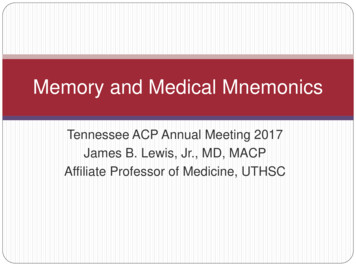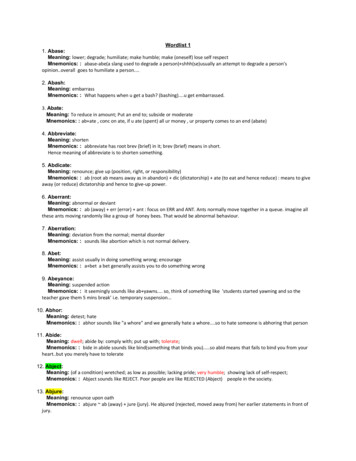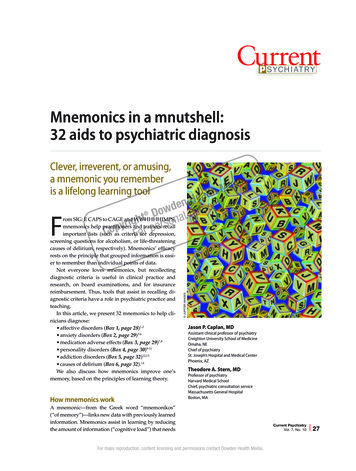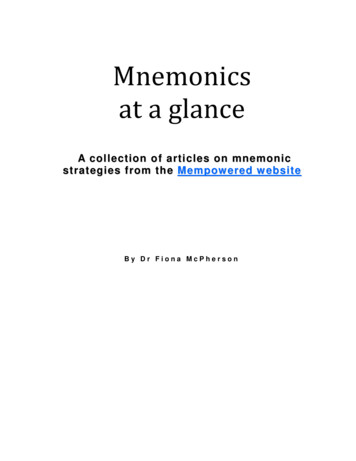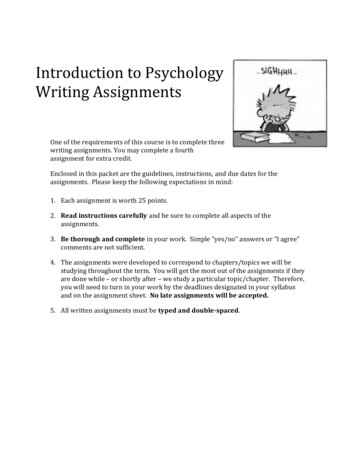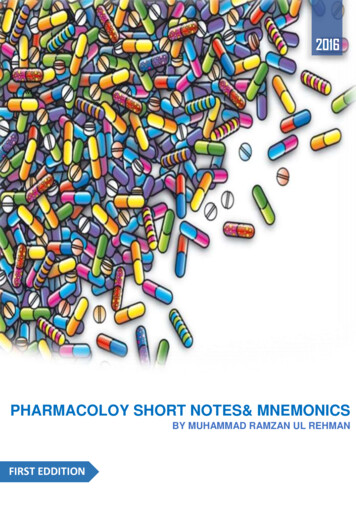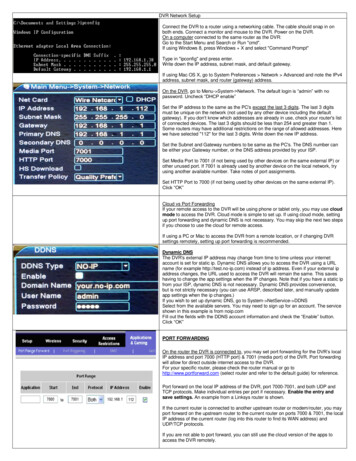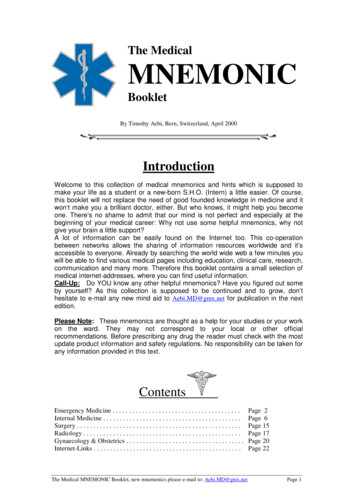
Transcription
The MedicalMNEMONICBookletBy Timothy Aebi, Bern, Switzerland, April 2000IntroductionWelcome to this collection of medical mnemonics and hints which is supposed tomake your life as a student or a new-born S.H.O. (Intern) a little easier. Of course,this booklet will not replace the need of good founded knowledge in medicine and itwon‘t make you a brilliant doctor, either. But who knows, it might help you becomeone. There‘s no shame to admit that our mind is not perfect and especially at thebeginning of your medical career: Why not use some helpful mnemonics, why notgive your brain a little support?A lot of information can be easily found on the Internet too. This co-operationbetween networks allows the sharing of information resources worldwide and it’saccessible to everyone. Already by searching the world wide web a few minutes youwill be able to find various medical pages including education, clinical care, research,communication and many more. Therefore this booklet contains a small selection ofmedical internet-addresses, where you can find useful information.Call-Up: Do YOU know any other helpful mnemonics? Have you figured out someby yourself? As this collection is supposed to be continued and to grow, don’thesitate to e-mail any new mind aid to Aebi.MD@gmx.net for publication in the nextedition.Please Note: These mnemonics are thought as a help for your studies or your workon the ward. They may not correspond to your local or other officialrecommendations. Before prescribing any drug the reader must check with the mostupdate product information and safety regulations. No responsibility can be taken forany information provided in this text.ContentsEmergency Medicine . . . . . . . . . . . . . . . . . . . . . . . . . . . . . . . . . . . . . . .Internal Medicine . . . . . . . . . . . . . . . . . . . . . . . . . . . . . . . . . . . . . . . . . .Surgery . . . . . . . . . . . . . . . . . . . . . . . . . . . . . . . . . . . . . . . . . . . . . . . . . .Radiology . . . . . . . . . . . . . . . . . . . . . . . . . . . . . . . . . . . . . . . . . . . . . . . .Gynaecology & Obstetrics . . . . . . . . . . . . . . . . . . . . . . . . . . . . . . . . . . . .Internet-Links . . . . . . . . . . . . . . . . . . . . . . . . . . . . . . . . . . . . . . . . . . . . .Page 2Page 6Page 15Page 17Page 20Page 22The Medical MNEMONIC Booklet, new mnemonics please e-mail to: Aebi.MD@gmx.netPage 1
Emergency MedicineEssential Steps For Heart AttacksWhen dealing with a myocardial infarction remember that ‘Time Is Muscle’! Yourpatient might be terrified; reassure him. Act fast, attach an ECG monitor and ensurea defibrillator trolley is on hand. Most deaths occur within the first hour of the onset ofAMI and are usually due to ventricular fibrillation.The following little and very simple phrase will remind you of the first (maybe evenprehospital) steps to think of:“OH MAN”O:H:Oxygen, high-flow O2 (unless CO2 retaining, eg COPD)Heparin, eg 80 units/kg, followed by a continuous infusion of 18 units/kg/h.This is not done everywhere, so check out local recommendations.M:Morphine, eg 5mg IV (therefore always place an IV cannula). It is: analgesic,anxiolytic, anti-arrhythmic and venodilatory. Please always consider an antiemetic like metoclopramide.Aspirin , eg 300mg should be given as soon as possible, unlesscontraindicatedNitro-glycerine, eg capsule or spray sublingually for coronary vasodilatationA:N:The Heart Attack And Its EnzymesIt’s a very common question you are asked as a student, and funny enough youalways get those enzymes mixed up, although you have learned them several timesbefore. Here’s some help: Remember „CArdiaL“In myoCArdiaL infarctionC:A:L:CK (CK-MB) goes up firstASAT (GOT) goes up secondLDH goes up thirdHandling The Pulmonary OedemaAs this medical emergency involves the Lungs, start with the L and follow the lettersof the alphabet. LMNOP.The Medical MNEMONIC Booklet, new mnemonics please e-mail to: Aebi.MD@gmx.netPage 2
L:M:N:O:P:Lasix (furosemide), eg 40-80mg IV slowlyMorphine, eg 2,5-5mg IV (subcutaneous application is effective in mildercases). Avoid respiratory depression!Nitro-glycerine, capsule or spray sublingually, consider isosorbide dinitrate(ISDN) IVOxygen by face mask: 100% if no pre-existing lung diseasePosition the patient sitting up with his legs dangling over the side of the bed.This facilitates respiration and reduces venous return!Staying Calm In Acute Severe Asthma Or An ExacerbatedCOPDAnyone who has ever experienced an exacerbation of a COPD knows in what panicsituation such a patient can get. And even you as the one who should help could endup panicking, but: An atmosphere of calm helps cure the Patient! And be careful: theseverity of an asthmatic attack is easily underestimated.The mnemonic „SHO and CIA“ I found to be extremely helpful, when working oncasualty.S:H:O:C:I:A:Salbutamol nebulized through a mask, or if not available use a „spacer“Hydrocortisone, eg 100-200mg IV. This of course will take some time to showits benefit!Oxygen! Sit Patient up and give O2 in high-dose. Beware: Patients withCOPD, especially if they are CO2-retaining (type 2 respiratory failure) havetheir right for oxygen, but they have to be under constant surveillance!Chest X-ray. Pneumothorax is a common complication and can be lifethreatening. Always do a chest x-ray!Ipratropium bromide. Add to the nebulized ß-agonist.Aminophylline Theophylline (Consider!), eg 250mg IV over 20mins.Beware: Avoid β-blockers and NSAID in asthmatic patients, they can worsen thesituation significantly!Explanation: The SHO (Senior House Officer) in Ireland or Great Britain is theequivalent to the American „Intern“ or the Swiss „Assistenzarzt”.Trauma Requires Fast ThinkingIn initial trauma management every second saves lives. You must think „FAST“about immediate life-threatening conditions, and if present treat them.F:A:S:T:Flail chest traumaAirway compromise or obstructionSucking chest wound and Shock tamponadeTension pneumothoraxBy being confronted with a multi-trauma patient, there might be no time for x-rays orany tests, just pure clinical judgement and immediate treatment.The Medical MNEMONIC Booklet, new mnemonics please e-mail to: Aebi.MD@gmx.netPage 3
Pain Assessment – Made EasySometimes on casualty it is extremely important to assess pain exactly. To ask all 10important points about pain gives you all the necessary information. The onlyproblem is, that every time you should remember all those questions, you don’t.The following mnemonic proved to be very helpful! Remember:„the SRN (Senior Register Nurse) at the OPD (Out Patient Department) is verityAggravating factorsRelieving factorsAssociated Senior Register Nurse dt. „Oberschwester“Out Patient Department dt. „Poly- oder Tagesklinik“Causes Of ComaThe Mnemonic "MIDAS" will help you remember important states to exclude as acause of coma, especially in stressful sAir! Respiratory failureSubdural or Suarachnoid haemorrhageThe Cholinergic OverdoseThe word „SLUDGE“ is a very simple reminder of the clinical features of a ionUrinationDiarrhoeaGastric upsetEmesisAnd additionally miosis, muscle weakness and bradycardia!The Medical MNEMONIC Booklet, new mnemonics please e-mail to: Aebi.MD@gmx.netPage 4
The Anticholinergic OverdoseThis is not really a mnemonic than rather a picture describing you these clinicalfeatures:Blind as a batDry as a boneRed as a beetMad as a hatterHot as a hareAnd additionally mydriasis, absent bowel sounds, urinary retention!Facing Malignant HyperthermiaThis is a rare complication during anaesthesia. There is rapid raise in temperature(eg 1 C every 5 minutes, up to 43 c) and acidosis due to rigidity. Prompt treatment isvital and following mnemonic can be helpful as a basic guideline for treatment in sucha situation:"SOme Hot Dude Better Give Iced Fluid Fast!"SO:H:D:B:G:I:F:Fast:Stop all triggering agents first! Give 100% Oxygen.HyperventilateDantrolene, eg 1mg/kg every 5 minutes IV – up to 10 mg/kg in totalBicarbonate (Consider)Glucose and InsulinIV-fluids, 'Icy'/cool blanketFluid output (check!), FurosemideTachycardiaThe Medical MNEMONIC Booklet, new mnemonics please e-mail to: Aebi.MD@gmx.netPage 5
Internal MedicinePossible Causes For IllnessWhen facing a constellation of symptoms and signs, it may be helpful to try to relatethem to a single underlying disease process.“VINDICATE” will help you to think of all possible pathologic groups causing matic, toxicendocrineThe Essential Of AsthmaWhen asked the exact definition of asthma: Don’t think too far, just remember„ASTHMA“! And do respect Asthma: people still die of it!A:S:T:H:M:A:Airway obstructionSpasm of bronchial muscle*Transient (!) and reversibleHigh mucus production*Mucosal swelling/inflammation*Attack comes paroxysmal* these are the 3 main factors which narrow the airways!Talking About AsthmaSalbutamol is a selective β2 adrenoreceptor agonist and acts on the airways. So toremember where which receptor is, just note:"One Heart, Two Lungs"Beta-1 primarily on the heartBeta-2 in the airwaysThe Medical MNEMONIC Booklet, new mnemonics please e-mail to: Aebi.MD@gmx.netPage 6
Possible Causes Of HypoglycaemiaThis is a great little mnemonic to remind you of the most important causes ofhypoglycaemia. This is the commonest endocrine emergency, so prompt diagnosisand treatment is essential! By definition a hypoglycaemia is plasma glucose 2.5mmol/L. Threshold for symptoms varies.Remember: “EXPLAIN Malaria”Ex:P:L:A:I:N:Exogenous drugs, eg insulin or chlorpropamide; Alcohol, eg alcoholic on abinge with no food; and others like atorvastatin, ACE-inhibitors etc.Pituitary insufficiencyLiver failure plus some rare inherited enzyme defectsAddison’s diseaseIslet cell tumours (insulinoma) and immune hypoglycaemia (eg anti-insulinreceptor antibodies in Hodgkin’s disease)Non-pancreatic neoplasms (especially fibro sarcoma andhaemangiopericytomas)Malaria: especially with quinine administration!Clinical Presentation Of HyperthyroidismFollowing findings should cause a little „STING“ in your brain and remind you ofhyperthyroidism:S:T:I:N:G:SweatingTremor and TachycardiaIntolerance to heat, Irregular Menstruation and IrritabilityNervousnessGoitre and Gastrointestinal symptoms (like loose stools, diarrhoea)Probing Questions On AlcoholismEvery Physician will have to face the problem of alcoholism over and over again.Denial is a leading feature in this disease and therefore you can use specificquestions to evaluate, if there is a severe problem with alcohol. Besides thesequestions, which are quite sensitive, always be sure to question relatives too.Approach 1: The „CAGE“-questionsC hange:A angry:G uilty:E ye-opener:Has anybody ever asked you to change your drinking habits?Have you ever been angry about other people complaining?Did you ever feel guilty?Do you need an „eye-opener“ in the morning?The Medical MNEMONIC Booklet, new mnemonics please e-mail to: Aebi.MD@gmx.netPage 7
Approach 2: The mnemonic „CONTROL“Can you always Control your drinking?Has alcohol ever led you to Neglect your family or your work?What Time do you start drinking? Do you sometimes start before this?Do friends comment on how much you drink or ask you to Reduce intake?Do you ever drink in the mornings to Overcome a hangover?Go through an average day’s alcohol, Leaving nothing out.Identifying Parkinson’s DiseaseParkinsonism is a syndrome which literally entraps the patient slowly. So keep theword “TRAP” in mind for the important clinical features of this disease:T:R:A:P:Tremor, 3-6Hz (cycles per second). It’s most marked at rest and often seenas a so called ‘pill rolling' of thumb and fingers.Rigidity, limbs resist passive extension throughout movement (not spasticity!).Cogwheel rigidity (dt. Zahnradphänomen) is combined rigidity and tremor.Akinesis or bradykinesisPosture typical of a Parkinson’s patient and Postural instabilityAdditional features are monotonous speech ( /- dysarthria), expressionless face,dribbling, short shuffling steps, difficulty stopping and starting walking, blinkrate , fidgeting , peristalsis , micrographia and ‘couche-volant’.Big BellyThe differential diagnosis of an abdominal distension includes „the 5 F“ and one T:F:F:F:FatFoetusFaecesF:F:T:FluidFlatusTumorBasic Hypertension TreatmentThink of "WATER" when evaluating patients for hypertension:W:A:T:E:R:Weight reductionAlcohol use Tobacco use (smoking or chewing)ExerciseRestriction of saltThe Medical MNEMONIC Booklet, new mnemonics please e-mail to: Aebi.MD@gmx.netPage 8
Medical Hypertension TherapyThe therapy of hypertension has to be individually evaluated for each patient, but asan easy reminder of the basic possibilities here's "ABCD", as easy as the ABC!A:B:C:D:ACE-inhibitors (are first choice in the diabetic-they help prevent renal failure,they may be first choice if coexisting LVF)β-blocker, eg atenolol (if no asthma, heart failure, or claudication)Calcium antagonist, eg amlodipine (SE: flushing, fatigue, gum hyperplasia,oedema)Diuretics, eg Bendrofluazide (SE!)Basically A and B are preferred in younger patients, C and D in the elderly (this isjust thought as a basic idea).Acute Rheumatic FeverThis illness is due to cross-reactivity with β-haemolytic streptococci. The diagnosis isbased on the revised JONES-Criteria. It can be made in the presence of evidence ofprevious streptococcal infection plus 2 major criteria or 1 major and 2 minor criteria.The major criteria are very easy to keep as they are already listed in:“JONES-Criteria”Jo:N:E:S:Joints red and tender due to migratory (‘flitting’) polyarthitis (75%)Nodules, subcutaneous nodules (2-20%)Erythema marginatum on trunk, thighs, arms (2-10%)Sydenham’s chorea (10%, St Vitus dance dt. Veiztanz), commoner iffemale. These odd darting movements are usually a late sign.C:Carditis (endo-, myo-, or pericarditis)Note: The minor criteria include fever, raised ESR or CRP, arthralgia (but not ifarthritis is one of the major criteria), history of previous rheumatic fever andprolonged P-R interval (but not if carditis is one of the major criteria)ST Elevation in ECG’sThe possible causes of ST elevation in an ECG are listed in the word “ELEVATION”:E:L:E:V:A:T:I:O:N:ElectrolytesLBBB (left bundle branch block)Early repolarisationVentricular hypertrophyAneurysmTreatment – pericardiocentesisInjury (acute myocardial infarction, contusion)Osborne waves (in hypothermia)Non-occlusive vasospasmThe Medical MNEMONIC Booklet, new mnemonics please e-mail to: Aebi.MD@gmx.netPage 9
Sleep Apnoe Syndrome And The Number 10To keep the very essential of the definition and epidemiology in your mind,use four times 10:-By definition more than 10 apnoe periods longer than 10 seconds per hourAbout 10% of all males over 40 affectedMen 10 times more affected than womenPheochromocytoma And The Number 10Number 10 will remind you of some important features of pheochromocytoma (whichare discussed 10 times more often than actually seen):10% malignant10% bilateral10% extra adrenal10% calcified10% children10% familialWhen Elderly People FallWhen ever you get into touch with an elderly patient who has fallen or fainted you’llsurely think of all the cardiovascular causes first. But there are some special causesyou should always keep in mind (and which are often neglected):Remember: “DAME”D:A:M:E:Drugs (always take a full history including all drugs involved, ask relatives ifnecessary)Ataxiahigher Mental dysfunctionEnvironment (a carpet with a little fold can be disastrous, consider removingloose carpets at home), Eyes (check visual abilities)Who Is Who In PneumoniasWhich bacteria cause community-acquired pneumonias and which are the mostcommon ones? There's hardly any student who hasn't been asked this question, andthere's hardly anyone who hasn't forgotten at least one of them. So remember:"Street Climbers Have My Legs"Streptococcus pneumoniae is the commonest (40-80%)Chlamydia pneumoniae or psittaci (causes psittacosis via parrots)Haemophilus influenzaeMycoplasma pneumoniaeLegionella pneumophilaThe Medical MNEMONIC Booklet, new mnemonics please e-mail to: Aebi.MD@gmx.netPage 10
For hospital acquired pneumonias remember "SPEK":S:P:E:K:Staphylococcus aureusPseudomonas aeruguinosaEnterobacteria, gram-negativeKlebsiellaPneumonia in the Immune CompromisedThe four most common pneumonia in patients with immunodeficiency disorders arelisted inthe four C’s:C:C:C:C:Pneumocystis Carinii pneumoniaCryptococcus neoformansCytomegaly virusCandida albicansIdentifying Osler's NodesBasically: Fever new regurgitant murmur endocarditis until proven otherwise!Here are the four P's to help you to identify Osler's nodes in infective endocarditis:P:P:P:P:PinkPainfulPea-sizedon the Pulp of the fingers or toesThe Causes Of Hemorrhagic EffusionThis little hint gives you a first idea of what can cause a hemorrhagic pleural effusion,it's:the four T's:T:T:T:T:TumourTuberculosisTraumaThrombosisThe Medical MNEMONIC Booklet, new mnemonics please e-mail to: Aebi.MD@gmx.netPage 11
Causes Of Red UrineWhen ever you're asked about the causes of haematuria, just relax, "SITTT" downand isBy the way: rifampicine (Rimactan ) makes the urine orange.COPD-ComplicationsThe COPD patient is in danger of developing special complications, which shouldalways be considered when his state is suddenly worsening: Think of “PICA”!P:I:C:A:Pneumothorax (especially in sudden respiratory failure or in anyexacerbation. Always do a chest x-ray!)Infiltrates (Pneumonia)Cor PulmonaleAtelectasisFor treatment of COPD-exacerbation see “Emergency Medicine” above.Carpal Tunnel SyndromeMultiple diseases can cause this quite common syndrome. Therefore, followingmnemonic could be quite useful:“ARMPIT”A:R:M:P:I:T:Acromegaly, AmyloidosisRheumatoid arthritisMyxoedemaPregnancy and PillIdiopathic (most common by the way!)Trauma, TuberculosisSigns Of Chronic Liver DiseaseBeing aware of all the pathophysiologic pathways involved, most of these clinicalfeatures should be clear. But if you still have some problems gathering themtogether, here’s a little help:“LAST JOG”L:A:S:T:Liver flapAscitesSpider NaeviTestis atrophyThe Medical MNEMONIC Booklet, new mnemonics please e-mail to: Aebi.MD@gmx.netPage 12
J:O:G:JaundiceOedemaGynaecomastiaPeptic Ulcer Disease RemindersPeptic ulceration includes either duodenal or gastric ulceration – 2 distinct entities (itmay also occur in Barrett's oesophagus or rarely in a Meckel's diverticulum).Dyspepsia is often the present complaint. Here's the "ABC" for the predisposingfactors of peptic ulcers:A:B:C:D:E:F:G:H:AnxietyBlood group 0Cigarette, CoffeeDrugs (especially Aspirin and Steroids, NSAID us risk 3-4 fold)Emotions (so called 'ulcer personality', the role of stress though iscontroversial)Family historyGastric hyper secretionHelicobacter pylori ( 90% of all duodenal ulcers are HP ve, and 80% of allgastric ulcerations are HP ve), HLA typePredisposing diseases are enclosed in "the 7 C's":C:CirrhosisC:Calcium (hyperparathyroidism)C:Chronic pancreatitisC:Cystic fibrosisC:Chronic renal failure/Cholestatic jaundiceC:COPDC:Calculi (renal)For complications it's "the 5 P's":P:PerforationP:Pyloric stenosisP:Peptic malignancyP:Penetration into pancreasP:Plus haemorrhage (which may be catastrophic)Note: Benign gastric ulcers are not premalignant. But: Gastric cancer may presentthis way, and it's prognosis is better if caught early, so all suspected GU must beendoscoped!The Medical MNEMONIC Booklet, new mnemonics please e-mail to: Aebi.MD@gmx.netPage 13
The Little Reminder In ImmunologyGell & Coombs classified the hypersensitivity reactions into four groups. So, if youstill have some problems keeping them in your mind, maybe a little “ACID” might helpyou:Type IType IIType IIIType ed hypersensitivityShowing Off In HaematologySome of you might think that keeping all these values in your mind is not worthwhiledoing. But some professors will be impressed if you know them by heart, and younever know if you won't be glad to know them on the ward too.It’s the numbers 3 and 4 in haematology:1.34cm2 oxygen carried by 1g of HbAverage of 3.4 lobes per neutrophil cell3.4mg iron in each g Hb34mg bilirubin from each g HbSome More Haematological HelpAs a student or on the ward, it’s handy to have some values of the white blood cellcount (WBC) present. Remember:“Never Let Mum Eat Beans” and “60, 30, 6, 3, ophilsBasophils60%30%6%3%1%Helpful Reminder In DermatologyTo remember the criterions, which make a nevus suspicious to be malignant(Melanoma!), think of the alphabetical rule:A:B:C:D:E:AsymmetricalBorders are irregularColour is not uniformDiameter more than 6mmElevation of some parts in the lesionThe Medical MNEMONIC Booklet, new mnemonics please e-mail to: Aebi.MD@gmx.netPage 14
SurgeryCauses Of Acute PancreatitisThis is an unpredictable disease (mortality 5-10%) which is often managed onsurgical wards. But because surgery is not often involved, it is easy to think that thereis no acute problem - but THERE IS! This mnemonic is a perfect reminder on all thedifferent causes that can lead to an acute pancreatitis. As in any good mnemonic,either the most important or the most common cause appears at the top of the list.So, if asked by your consultant during an operation or some other occasion, just "GET :SteroidsMumpsAutoimmune (PAN)Scorpion venom (commonest cause in Trinidad!)Hyperlipidaemia ( Ca , hypothermia)ERCP, also EmboliDrugs: (azathioprine, asparaginase, mercaptopurine, pentamidine etc)also pregnancy; and often no cause is found!Acute Ischaemia Of The LimbThis emergency might be caused by an embolus, thrombosis, or trauma. There islittle difference in its clinical presentation: „the six P’s!“The limb is:P aleP ulselessP ainfulP aralysedP araestheticP erishing with cold, or causing P rostrationPost-OP FeverHere's the five "W" which are supposed to help you to determine the possiblecause(s) of fever in a patient who has undergone a surgical procedure recently. Araised temperature post-op should stimulate an infection screen:The Medical MNEMONIC Booklet, new mnemonics please e-mail to: Aebi.MD@gmx.netPage 15
W ind:W ound:W ater:W alk:W hiz:the pulmonary system is the primary source of fever in the first 48hours!check for signs of infection at the surgical sitecheck intravenous access site for signs of phlebitisdeep venous thrombosis can develop due to pelvic pooling orrestricted mobility related to pain and fatigueconsider urinary tract infection in patients who underwentcatheterisationPredisposing Factors for GallstonesHere's now the probably best known mnemonic to remember the risk factorspredisposing to gallstones: the five "F"F atF emaleF ortyF ertileF airMeckel’s Diverticulum And The Rule Of 2When discussing the issue of Meckel’s diverticulum it’s good to think of the number2, as this number has got a lot to do with this anatomical variety:2 inches long2 feet from the ileocoecal valve2% of the populationcommonly presents in the first 2 years of lifemay contain 2 types of epithelial tissueNote: 1 foot 30,48cm1 inch 2,54cmAfter Day-Case SurgeryBefore discharging a patient, be sure that “LEAP-FROG” is established:L:E:A:P:Lucid, not vomiting, and cough reflex establishedEasy breathing and easy urinationAmbulant without faintingPain relief post-op drugs dispensed and given. Does he understand dose?F:R:O:G:Follow up arrangedRhythm, pulse rate, and BP checked one last time. Is trend satisfactory?Operation site checked and explained to patientGP letter sent with patient or carer. He must know what has happened!The Medical MNEMONIC Booklet, new mnemonics please e-mail to: Aebi.MD@gmx.netPage 16
RadiologyDense BonesA dense area in a conventional bone x-ray can have various causes. First of all makesure that this is not due to any technical circumstances or a twisted exposure of thepatient. So if asked about the causes of pathologic dense bones remember that:“Regular Sex Makes Occasional Perversions Much More Pleasurable And Fantastic”R:S:M:O:P:M:M:P:A:F:Renal osteodystrophy (first there’s primary bone destruction, but then reactivesklerosis)Sickel-cell disease (due to ineffective O2-tranportation there’s hyperplasia ofthe bone marrow and therefore reactive bone proliferation, this new bonethough is less stable)MyelofibrosisOsteopetrosisPyknodysostosis (recessive inherited disorder with generalised osteosklerosisand abnormal growth of already exiting bones)MastocytosisMetastasis (especially from breast or prostate tumours)Paget’s diseaseAthletes (here this finding can be physiologic)Fluorosis (eg County Valais, Switzerland)When Bone Has DisappearedFor any bubbly or lytic bone lesion in a conventional x-ray remember“FEGNOMASHIC”. This will help you to think of all important causes possible:F:E:G:N:O:M:A:S:H:I:C:Fibrous dysplasiaEnchondroma, eosinophilic granulomaGiant cell tumourNon ossifying fibromaOsteoblastomaMetastasis and myelomaAneurysmale bone cystSolitary bone castHyperparathyroidism (so called 'brown tumour')InfectionChondroblastoma, chondromyxoid fibromaThe Medical MNEMONIC Booklet, new mnemonics please e-mail to: Aebi.MD@gmx.netPage 17
Metastasis In The BoneHere’s a nice little phrase encounting all important tumours that like to metastasise tothe bones:“Kinds Of Tumours Leaping Primarily To ostateThyroidBreastThe Salter ClassificationFor traumatolgy and radiology it is very helpful to have this classification present. Asyou might forget it after a while (like we all tend to forget things we don’t useregularly), maybe this mnemonic will help you keep it a little longer in your mind.In Salter Classification think of “SALTR”S:A:L:T:R:Slip of physisAbove physisLower than physisThrough physisRammed physisInterstitial Lung DiseaseThis mnemonic encompasses at least 80-90% of interstitial lung disease seen inclinical practice.It's the word osis XIdiopathic pulmonary fibrosisTumour (lymphangitic)FailureAsbestosis (and other dusts)Collagen vascular diseaseExtrinsic allergic alveolitis (eg farmer’s lung)DrugsThe Medical MNEMONIC Booklet, new mnemonics please e-mail to: Aebi.MD@gmx.netPage 18
Anterior Mediastinal MassHere’s the famous five T’s, representing common conditions which can produce ananterior mediastinal mass seen in a conventional chest x-ray pa/lateral.T:T:T:T:T:ThymomaTeratomaThyroid tumour/goitreTerrible lymphomaTortuous vesselsMiddle Mediastinal MassIt’s the “HABIT5” to keep in mind:H:A:B:I:T5:Hernia, HaematomaAortic aneurysmBronchogenic cyst/duplication cystInflammation (sarcoidosis, histoplasmosis, coccidiosis and tuberculosis)5 tumours (lung, lymphoma, leukaemia, leiomyoma, lymph node hyperplasia)'Pneumonic' For Cardiophrenic Angle Mass"Fat PAD" will remind you of five possible conditions to think of:Fat:Fat (easy ey!)P:A:D:Pericardial cystAdenopathy/AneurysmDiaphragmatic herniaWhen Lungs Become HoneycombedThere are various causes for so called honeycomb lungs. It has to do with"BIG istiocytosis XInterstitial pneumoniaPneumoconiosisSarcoidosisThe Medical MNEMONIC Booklet, new mnemonics please e-mail to: Aebi.MD@gmx.netPage 19
Gynaecology &Dangerous Situations During PregnancyIn obstetrics the most common causes for maternal death are listed in the Germanword "BEIL" (meaning axe), or "LIEB" (meaning nice):B:E:I:L:BleedingEclampsiaInfectionsEmboli in the LungsWhen Hellp Means HelpPregnancy induced hypertension is a complex of symptoms of which the cause is notfully understood yet (immunologic, disturbed prostaglandin metabolism, Mgdeficiency?). Especially teenage pregnancies and elderly primigravida are in danger.It is more often in diabetes, multigravida and rhesus-incompatibility, too. One specialform of pregnancy induced hypertension is the HELLP-syndrome:H:EL:LP:HaemolysisElevated Liver enzymesLow PlateletsProlonged BirthThere are various causes for a prolonged birth, which means an opening of thecervix 1cm/h. The reasons are listed in the 5 P's:P:P:P:P:P:Passenger too bigPassage too smallPower too littlePain too bigPatience too littleThe Medical MNEMONIC Booklet, new mnemonics please e-mail to: Aebi.MD@gmx.netPage 20
Evaluating The NewbornThe newborn's vitality is evaluated right after birth by using the score from VirginiaApgar (from 1953). A score is given for each sign at one and five minutes after thebirth. If there are any problems with the baby an additional score is given at 10minutes. A score of 7-10 is considered as normal, while 4-7 might require someresuscitative measures, and a baby with APGARs of 3 and below requires immediateresuscitation. The APGAR-score after 5 minutes is the prognostic most importantone:A:P:G:A:R:Activity/muscle tone (absent 0, arms or legs flected 1, full activity 2)Pulse (absent 0, 100 1, 100 2)Grimace/reflex irritability (no response 0, grimace 1, sneeze/cough/pullsaway 2)Appearance/skin colour (blue-grey 0, normal except for extremities 1,normal over entire body 2)Respiration (absent 0, slow/irregular 1, good/crying 2)Dangerous Infections During PregnancyTo memorize infections which can harm the embryo (until the 12th pregnancy week)or the foetus, think of the English word "TORCH" or the German "STORCH". Most ofthese infections are asymptomatic and can only be diagnosed by antibodies,microbiology or culture:S:T:O:R:C:H:SyphilisToxoplasmosisOthers (Listeriosis, Hep
The Medical MNEMONIC Booklet, new mnemonics please e-mail to: Aebi.MD@gmx.net Page 3 L: Lasix (furosemide), eg 40-80mg IV slowly M: Morphine, eg 2,5-5mg IV (subcutaneous application is effective in milder cases). Avoid respiratory depression! N: Nitro-glycerine, capsule or spray sublingually, consider isosorb
